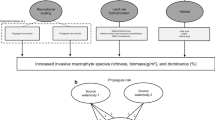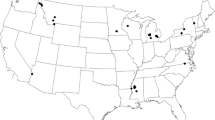Abstract
We built a family of hierarchical risk models for the spread of invasions by the spiny waterflea (Bythotrephes longimanus) in lakes in Ontario, Canada. Knowledge of covariates determining lake invasibility and ability to predict risk of future invasions may help to develop management policy and slow the invasions in the future. The models are based on two component submodels. The first component was a stochastic gravity submodel for the propagule pressure between lakes via recreational boaters. The second component was a submodel for establishment risk, given that the invader has already been introduced to a lake. This component was a logistic regression model, incorporating up to 17 measured covariates that describe the physical and chemical condition of the lake. Variants of the risk model, each incorporating different subsets of the covariates, were calibrated using presence/absence data from a 300-lake survey conducted in 2005–2006 by the Canadian Aquatic Invasive Species Network (CAISN). The predictive capacity of the best model was high, giving AUC values close to 0.94. Of the model covariates considered, the most important predictors of existing invasions were propagule pressure and lake pH, and, to lesser extents, phosphorus (P) and lake elevation. Our fitting of the propagule pressure submodel demonstrated a significant Allee effect for Bythotrephes. Our development of the establishment risk predictor showed that it is essential to account for temporal variability in lake physico-chemistry. We demonstrated that invasions of lake networks by the spiny waterflea follow highly predictable patterns which can be understood with a properly calibrated, hierarchical risk model.








Similar content being viewed by others
References
Barbiero RP, Tuchman ML (2004) Changes in the crustacean communities of Lakes Michigan, Huron and Erie following the invasion of the predatory cladoceran Bythotrephes longimanus. Can J Fish Aquat Sci 61:2111–2125
Bossenbroek JM, Kraft CE, Nekola JC (2001) Prediction of long-distance dispersal using gravity models: zebra mussel invasion of inland lakes. Ecol Appl 11:1778–1788
Branstrator DK, Brown ME, Shannon LJ, Thabes M, Heimgartner K (2006) Range expansion of Bythotrephes longimanus in North America: evaluating habitat characteristics in the spread of an exotic invader. Biol Invas 8:1367–1379
Burnham KP, Anderson DR (2001) Model selection and multimodel inference. A practical information-theoretic approach, 2nd edn. Springer, NY
Burnham KP, Anderson DR (2004) Multimodel inference: understanding AIC and BIC in model selection. Sociol Method Res 33:261–304
Cairns A, Elliott M, Yan ND, Weisz E (2006) Operationalizing CAISN project 1.V, Technical Report No. 1: lake selection. Technical report prepared for the Canadian aquatic invasive species network. Dorset Environmental Science Centre, Dorset, Ontario
Cairns A, Yan ND, Weisz E, Petruniak J, Hoare J (2007) Operationalizing CAISN project 1.V, Technical Report No. 2: the large, inland lake, Bythotrephes survey—limnology, database design, and presence of Bythotrephes in 311 south-central Ontario lakes. Technical report prepared for the Canadian Aquatic Invasive Species Network. Dorset Environmental Science Centre, Dorset, Ontario
Carroll RJ, Ruppert D, Stefanski LA (1995) Measurement error in nonlinear models. Chapman & Hall, London
Clark JS, Carpenter SR, Barber M et al (2001) Ecological forecasts: an emerging imperative. Science 293:657–660
Cox ET (1978) Counts and measurements of Ontario lakes: watershed unit summaries based on maps of various scales by watershed unit. Ontario Ministry of Natural Resources, Toronto
Crawley MJ (2007) The R book. Wiley, USA
Drake JM, Bossenbroek JM (2004) The potential distribution of zebra mussels (Dreissena polymorpha) in the USA. Bioscience 54:931–941
Drake JM, Baggenstos P, Lodge DM (2005) Propagule pressure and persistence in experimental populations. Biol Lett 1:480–483
Ghosh JK, Samanta T (2001) Model selection—an overview. Curr Sci 80:1135–1144
Guisan A, Thuiller W (2005) Predicting species distribution: offering more than simple habitat models. Ecol Lett 8:993–1009
Gurevitch J, Padilla DK (2004) Are invasive species a major cause of extinctions? Trends Ecol Evol 19:470–474
Herborg L-M, Mandrak NE, Cudmore BC, MacIsaac HJ (2007) Comparative distribution and invasion risk of snakehead (Channidae) and Asian carp (Cyprinidae) species in North America. Can J Fish Aquat Sci 64:1723–1735
Jerde C, Lewis MA (2007) Waiting for invasions: a framework for the arrival of non-indigenous species. Am Nat 170:1–9
Jerde CL, Bampfylde CJ, Lewis MA (2009) Chance establishment for sexual, semelparous species: overcoming the Allee effect. Am Nat 173(6):734–746
Keller RP, Lodge DM, Lewis MA, Shogren JF (eds) (2009) Bioeconomics of invasive species. Oxford University Press, NY
Kim N, Yan ND (2010) Methods for rearing the invasive zooplankter Bythotrephes in the laboratory. Limnol Oceanogr Methods 8 (in press)
Lele S, Keim JL (2006) Weighted distributions and estimation of resource selection probability functions. Ecology 87:3021–3028
Leung B, Mandrak NE (2007) The risk of establishment of aquatic invasive species: joining invasibility and propagule pressure. Proc R Soc Lond Ser B 274:2603–2609
Leung B, Drake JM, Lodge DM (2004) Predicting invasions: propagule pressure and the gravity of Allee effects. Ecology 85:1651–1660
Linneman HV (1966) An econometric study of international trade flows. North-Holland Publishing Company, Amsterdam
Lockwood JL, Cassey P, Blackburn T (2005) The role of propagule pressure in explaining species invasions. Trends Ecol Evol 20:223–228
MacIsaac HJ, Ketelaars HAM, Grigorovich IA, Ramcharan CW, Yan ND (2000) Modeling Bythotrephes longimanus invasions in the Great Lakes basin based on its European distribution. Archive für Hydrobiologie 149:1–21
MacIsaac HJ, Borbely JVM, Muirhead JR, Graniero PA (2004) Backcasting and forecasting biological invasions of inland lakes. Ecol Appl 14(3):773–783. doi:10.1890/02-5377
Muirhead JR (2007) Forecasting dispersal of nonindigenous species. PhD thesis, University of Windsor, Windsor
Muirhead JR, MacIsaac HJ (2005) Development of inland lakes as hubs in an invasion network. J Appl Ecol 42:80–90
Pearce JL, Boyce MS (2006) Modelling distribution and abundance with presence-only data. J Appl Ecol 43:405–412
Pepe MS (2003) The statistical evaluation of medical tests for classification and prediction. Oxford University Press, Oxford
Pérez-Fuentetaja A, Dillon PJ, Yan ND, McQueen DJ (1999) Significance of dissolved organic carbon in prediction of thermocline depth in small Canadian Shield lakes. Aquat Ecol 33:127–133
Pimentel D, Zuniga R, Morrison D (2005) Update on the environmental and economic costs associated with alien-invasive species in the United States. Ecol Econ 2005:273–288
Potapov A (2009) Stochastic model of lake system invasion and its optimal control: neurodynamic programming as a solution method. Nat Res Mod 22:257–288
Potapov A, Muirhead JR, Lele SR, Lewis MA (2010) Stochastic gravity models for modeling lake invasions. Ecol Model 222:964–972
Pulliam HR (2000) On the relationship between niche and distribution. Ecol Lett 3:349–361
Romeijn HE, Smith RL (1994) Simulated annealing for constrained global optimization. J Glob Optim 5:101–126
Sala OE, Chapin FS III, Armesto JJ, Berlow E, Bloomfield J, Dirzo R, Huber-Sanwald E, Huenneke LF, Jackson RB, Kinzig A, Leemans R, Lodge DM, Mooney HA, Oesterheld M, Poff NL, Sykes MT, Walker BH, Walker M, Wall DH (2000) Global biodiversity scenarios for the year 2100. Science 287:1770–1774
Spall JC (2003) Introduction to stochastic search and optimization. Wiley, Hoboken
Stefanski LA, Carroll RJ (1985) Covariate measurement error in logistic regression. Ann Stat 13:1335–1351
Stockwell D (2007) Niche modeling: predictions from statistical distributions. Chapman and Hall, Boca Raton
Strecker AL, Arnott SE (2005) Impact of Bythotrephes invasion on zooplankton communities in acid-damaged and recovered lakes on the Boreal Shield. Can J Fish Aquat Sci 62:2450–2462
Taylor CM, Hastings A (2005) Allee effects in biological invasions. Ecol Lett 8(8):895–908
R Development Core Team (2009) R: a language and environment for statistical computing. R Foundation for Statistical Computing, Vienna, Austria. ISBN 3-900051-07-0. http://www.R-project.org
Thomas RW, Huggett RJ (1980) Modeling in geography: a mathematical approach. Rowman and Littlefield, Lanham
Weisz EJ, Yan ND (2010) Relative value of limnological, geographic, and human use variables as predictors of the presence of Bythotrephes longimanus in Canadian Shield lakes. Can J Fish Aquat Sci 67(3):462–472
Wittmann MJ, Lewis MA, Young JD, Yan ND (2011) Temperature-dependent Allee effects in a stage-structured model for Bythotrephes establishment. Biol Invasions. doi:10.1007/s10530-011-0074-z
Yan ND, Pawson TW (1998) Variation in size and abundance of the exotic invader Bythotrephes cederstroemi in Harp Lake, Canada. Hydrobiologia 361:157–168
Yan ND, Dunlop WI, Pawson TW, MacKay LE (1992) Bythotrephes cederstroemi (Schoedler) in Muskoka lakes: first records of the European invader in inland lakes in Canada. Can J Fish Aquat Sci 49(2):422–426. doi:10.1139/f92-048
Yan ND, Girard R, Boudreau S (2002) An introduced invertebrate predator (Bythotrephes) reduces zooplankton species richness. Ecol Lett 5:481–485
Yan ND, Paterson AM, Somers KM, Scheider WA (2008) An introduction to the Dorset special issue: transforming understanding of the factors that regulate aquatic ecosystems on the southern Canadian Shield. Can J Fish Aquat Sci 65:781–785
Zipf GK (1946) The P1P2/D hypothesis: on the intercity movement of persons. Am Soc Rev 11:677–686
Acknowledgments
This research has been supported by Canadian Aquatic Invasive Species Network, by NSERC and by a Canada Research Chair (ML). We want to thank A. Paterson, Ontario Ministry of Environment, for data on variability of chemical covariates, and A. Cairns of York University for running the sampling program for the 300 lakes, assembling the 300 lake database.
Author information
Authors and Affiliations
Corresponding author
Appendices
Appendix A
For the function Q in Eq. 7 we have the following expression:
For small μ \( Q\left( {\mu ,m} \right) \approx \mu^{m} /m! \), for μ big Q(μ, m) approaches 1. It is convenient to replace the sum by an empirical approximation with qualitatively similar behavior: \( Q\left( {\mu ,m} \right) \approx Q_{1} \left( {\mu ,m} \right) = 1 - \exp \left( { - \frac{{\mu^{m} }}{m!}} \right). \)
Or, in terms of the relative boater flow λ,
where κ should be fitted from data.
We have tried another possible approximation to Q, \( Q_{2} \left( {\mu ,m} \right) = \left[ {1 - \exp \left( { - \mu /\left( {m!} \right)^{1/m} } \right)} \right]^{m} .\) It have shown slightly worse model performance, though formally it provides closer approximation to Q(μ, m). Both approximations are compared in Fig. 9.
Comparison of exact Q(λ, m) and its approximations for m = 2 and 3: black solid line—exact Q(λ, m); dashed—\( Q_{1} \left( {\lambda ,m} \right) = 1 - \exp \left( { - \lambda^{m} /m!} \right) \); dotted line—\( Q_{1} \left( {\lambda ,m} \right) = 1 - \exp \left( { - \alpha \lambda^{m} /m!} \right) \) where α is obtained by fitting Q 1 to Q, (actual coefficient will be fitted anyway); gray line \( Q_{2} \left( {\lambda ,m} \right) = \left[ {1 - \exp \left( { - \lambda /\left( {m!} \right)^{1/m} } \right)} \right]^{m} \)
Appendix B
With the help of Eq. 11, formula (10) can be written as
where
Introduce a change of variables,
then we have one-to-one relation between ξ 0 and η, there exists the inverse change ξ 0(η), and hence we can write
We approximate this integral by a finite sum over n 0 points using midpoint rule. The interval [0, 1] we split into n 0 segments of the length 1/n 0, with the middle in the points \( \eta_{j} = (j - 0.5)/n_{0} \), \( j = 1, \ldots ,n_{0} \). The corresponding values of ξ 0j can be obtained from (B3), and they coincide with the probabilities that \( {\text{Prob}}(\xi_{0} < \xi_{0j} ) = \eta_{j} = (j - 0.5)/n_{0} \). Substituting these values of ξ 0j into (B4), we obtain Eq. 12.
Rights and permissions
About this article
Cite this article
Potapov, A., Muirhead, J., Yan, N. et al. Models of lake invasibility by Bythotrephes longimanus, a non-indigenous zooplankton. Biol Invasions 13, 2459–2476 (2011). https://doi.org/10.1007/s10530-011-0075-y
Received:
Accepted:
Published:
Issue Date:
DOI: https://doi.org/10.1007/s10530-011-0075-y





